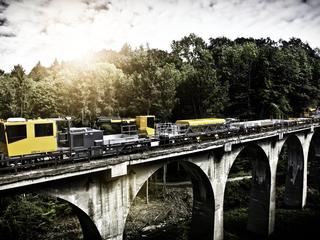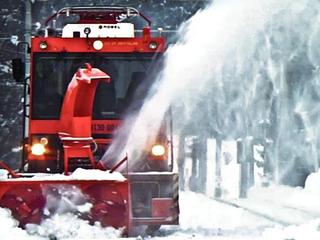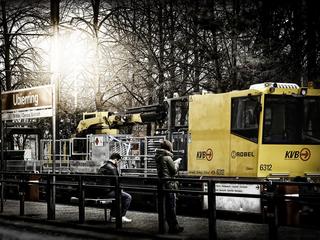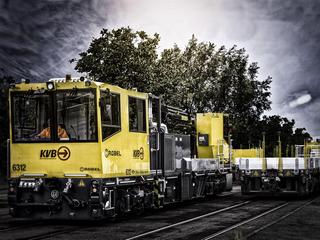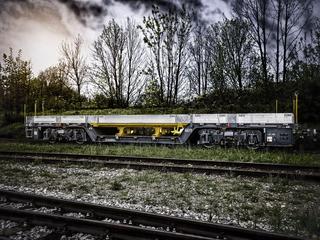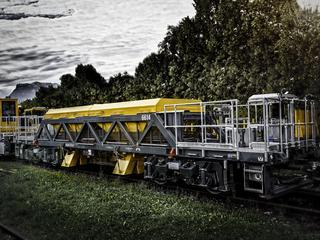





RORUNNER transport system
RORUNNER System KVB
Vehicle system for flexible urban construction logistics. Train combinations for every job in new construction and maintenance significantly reduce construction times.
- Use on all urban and suburban railway systems
- Material movement, recovery trip and winter service
- Transport of rails, ballast and heavy components directly to the platform
- Mixed operation according to BOStrab and EBO
- Precision stop up to top speed
- Full view of all road users
- Optional: operation of four vehicles by one operator
Please check the product sheet () for further information and accessories.
| Drive | 6-cylinder hydrostatic diesel engine | |||
| Type | Deutz, exhaust emission rating to RL97/68/EC Level IV final | |||
| Output | 390 kW; hydrostatic transmission of power to 3 axles | |||
| Weight | 37 t total weight incl. 2 t payload | |||
| Working mode | 60 km/h self-propelled, 60 km/h hauled | |||
| Dimension | 14.5 m total length over draw gear | |||
| Braking | Pneumatic direct/indirect, spring-actuated, magnetic rail brake, wheel slide protection (WSP also active during hauled drive) | |||
| Loading crane | PK 11502 B with height limiter and adjacent track locking | |||
| Max. outreach | 10,4 m | |||
Which components does the ROBEL Transport System consist of?
The system comprises
- 2 RORUNNER Track Vehicle (54.17)
- with crane and on-board auxiliary driver's cabin for push-pull operation
- 1 RORUNNER Track Vehicle without crane (54.17)
- 2 ROTRAILER Low-Loading Wagons (55.70/2) with various platform installations
- 1 ROTRAILER Long Rail Vehicle (55.70/3) for up to 18 m rails
- 1 ROTRAILER Ballast Transport Wagon (55.70/4)
- 1 ROTRAILER (55.70/5)
with high-pressure jetting and vacuum system for underground systems
With the eight vehicles, up to 16 different train combinations can be formed; these are designed for mixed operations according to EBON/A and BOStrab and can cover all transport tasks in urban maintenance operations.
What and how much can I transport using ROBEL's Transport System?
Payload:
- RORUNNER w/ crane: 2 t
- RORUNNER w/o crane: 3 t
ROTRAILER payload: up to 18 t
Compared to previous methods, the system will transport greater loads in less time:
- The general-purpose trailers carry sleepers and construction materials to platforms all of types - including low loading ones - occurring in the network.
- Heavy components such as ticket vending machines, groups of seats or transformers are taken straight to the destination platform.
- Cable reels, escalators, control cabinets, cleaning equipment, construction machinery
- Rails up to 18 metres long
- As opposed to just side tipping, up to 17 t of ballast can now also be dumped and spread centrally.
In a nutshell, you will need fewer trips for more material.
What are the retrofit options of the ROTRAILER low-loading wagon?
- Filler element and side walls
- Filler element and deflector walls
- Filler element, side and deflector walls
- Side walls and cable drum block
- Detachable skip
What is special about maintaining railway systems in public road traffic?
Maintenance in moving urban traffic puts high demands on the vehicles' acceleration and braking capabilities: They should be able to stop abruptly for other road users at any time. All wagons feature direct and indirect pneumatic brake systems, spring actuators (parking brake), magnetic track brakes and anti-skid / wheel slide protection.
Rapid braking essentially depends on a good view, particularly if the train is travelling at top speed (60 km/h) itself. The track vehicle features large windows on all sides and a pivoting driver's seat which provides the operator an unrestricted view of the platform edge, zebra crossings, signals and people or cars on the roadside. If used separately, the track vehicle's rear cabin gives a full view of what's happening on-site.
Why does urban infrastructural work have to be completed faster?
The high utilisation of the urban railways during the week and in some cases transport operating also throughout the night at weekends are a burden for the public networks and pose new challenges for infrastructure operators: Maintenance requirement is increasing, the available time slots available for it are decreasing.
Up to 90% of the urban maintenance work takes place during the night when the trains are not operating; on average a mere two to four hours are available for this maintenance work.
Thus, infrastructure work has to be better organised and faster to ensure that highly frequented lines remain available. There is little time for ad-hoc deployment due to broken rails or line damage. Therefore continuous maintenance and timely error correction are the prerequisites for fault-free operation.
RORUNNER System KVB
